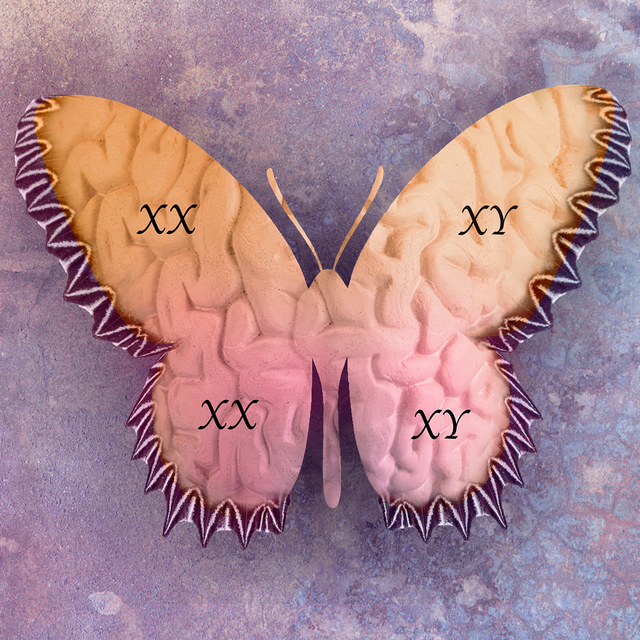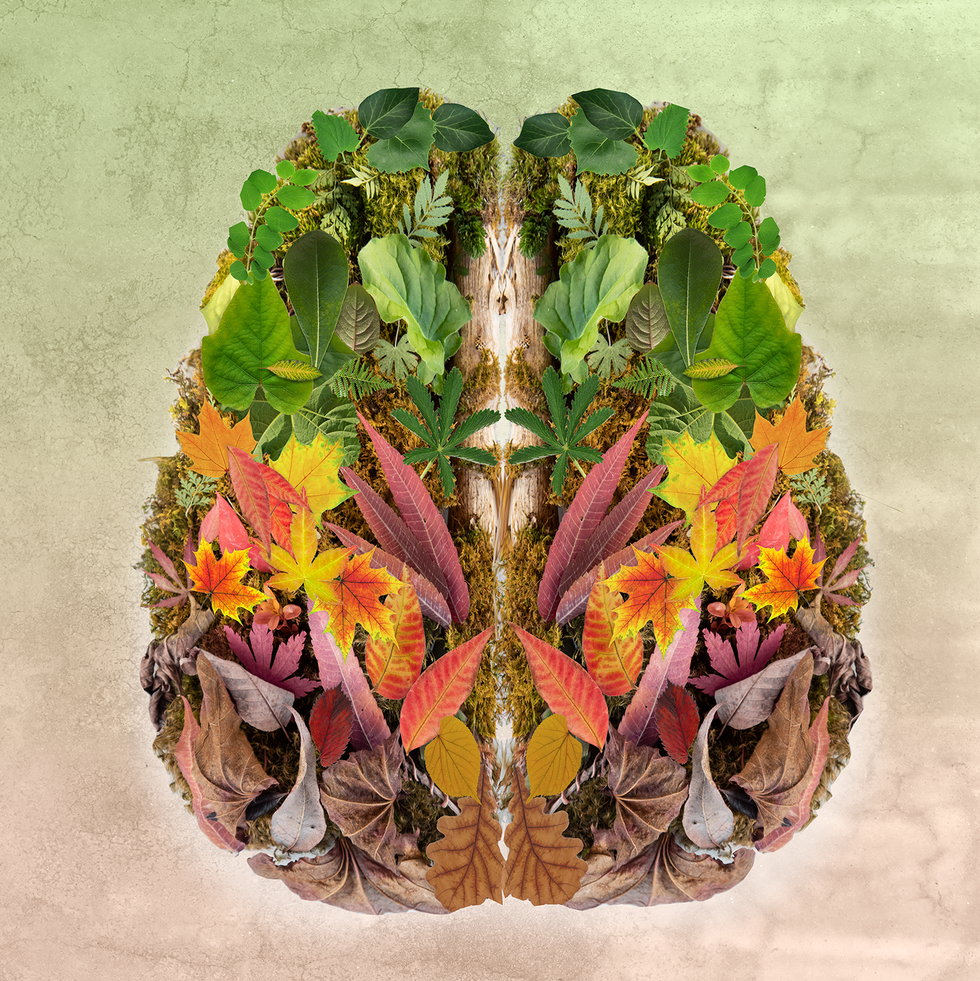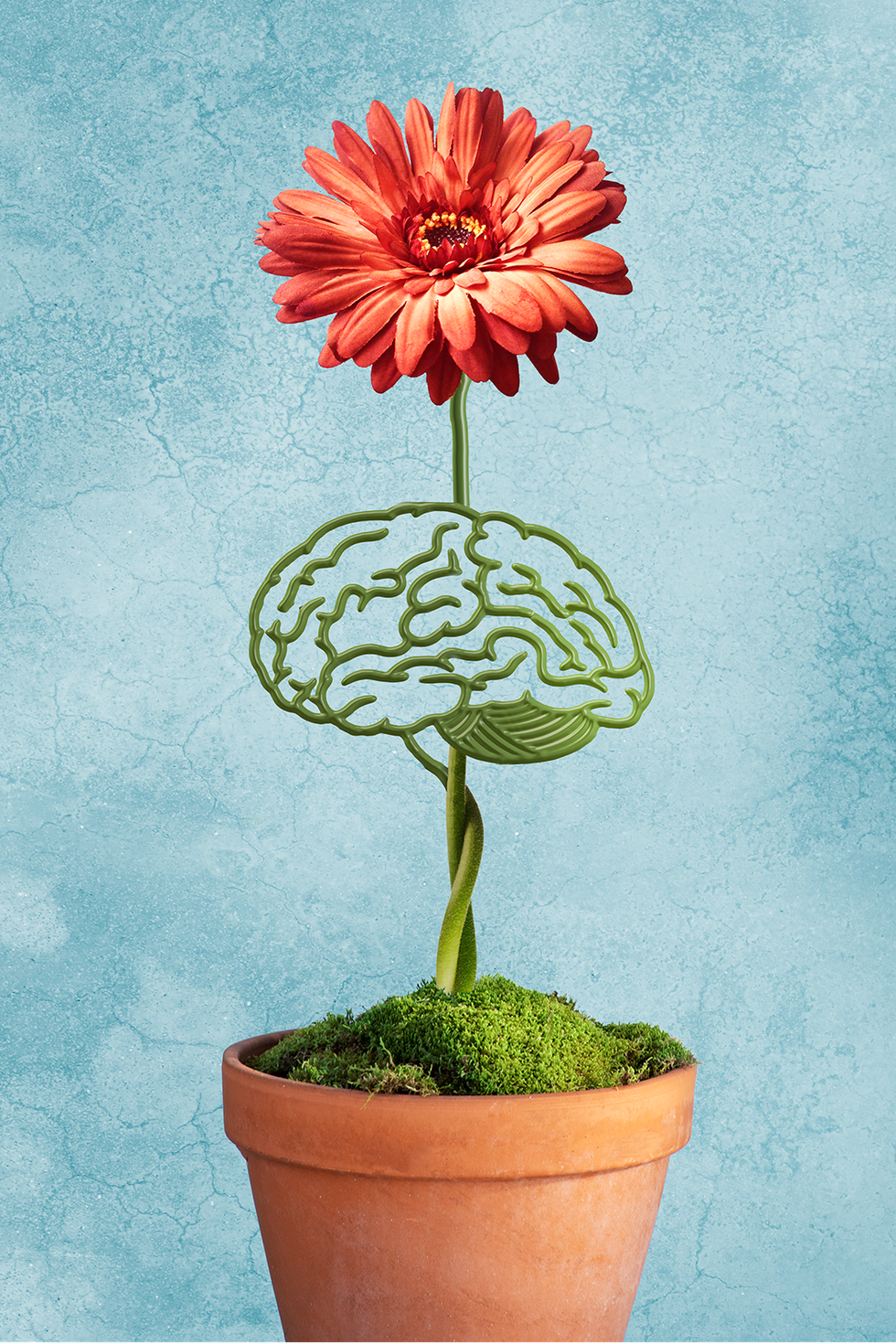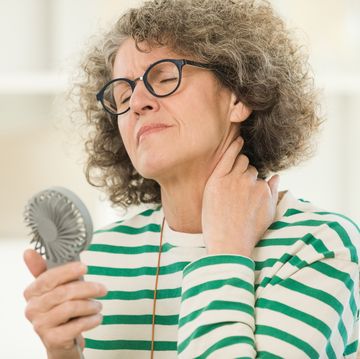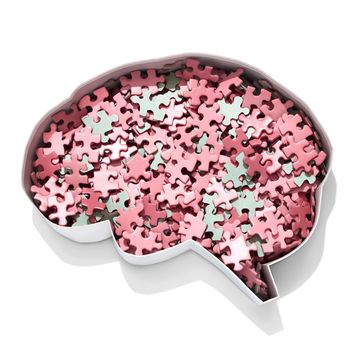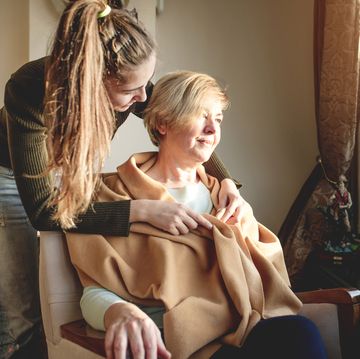The alarm bells started going off for neuroscientist Roberta Diaz Brinton, Ph.D., three decades ago, when she saw just how hard women in particular were being hit by Alzheimer’s disease. Consider these current stats: Nearly two-thirds of patients diagnosed with the brain disorder are women—a staggering one in five of us will be diagnosed by the time we’re 65—and by 2050, as many as 9 million women may end up with the disease. It’s even worse for African Americans, who are two to three times as likely as non-Hispanic whites to develop Alzheimer’s.
But when Brinton, the director of the Center for Innovation in Brain Science at the University of Arizona (and whose work has been supported for years by the Women’s Alzheimer’s Movement), went looking for answers, she found the status quo response to these stats unsatisfying at best and maddening at worst.
“I kept hearing over and over that it was because women live longer than men,” she says. “But we only live about four and a half years longer. That does not explain our twofold greater lifetime risk.”
It also doesn’t explain why a number of other brain-health issues affect women far more than men: Women are twice as likely as men to develop certain types of brain tumors, nearly twice as likely to deal with depression, and three times as likely to get headaches. We’re also much more likely to have a stroke and to develop an autoimmune disorder that affects the brain like multiple sclerosis.
Join the conversation about brain health: Top experts shared their insights and advice in You & Your Brain, a web series hosted by Prevention, HealthyWomen, and the Women’s Alzheimer’s Movement.
So Brinton and a number of her colleagues around the world started focusing on what might be going on specifically in women’s brains—beyond aging and unlucky genes—to lead to such higher rates of brain disease.
The answer became clear. “We know that Alzheimer’s disease can take about 20 years to develop prior to a diagnosis, and that the average age of an Alzheimer’s diagnosis is about 72 to 75,” says Brinton. “It doesn’t take a rocket scientist to do the math and see that when you subtract 20 from that average age of an Alzheimer’s diagnosis, you run into the average age of menopause, which is 51.”
Since Brinton’s aha moment, even more research has provided compelling reasons that women’s brains are more vulnerable than men’s to certain diseases. “Sex differences in our biologies—different chromosomes and hormones, for example—affect every chronic disease,” says Jill Goldstein, M.D., a professor of psychiatry and medicine at Harvard Medical School and executive director of the Innovation Center on Sex Differences in Medicine. “So does our gender, including things like social roles and expectations. I am more optimistic than ever that we can have an impact on how we prevent and treat disease if we pay attention to the importance of these differences.”
That’s the good news: Scientists have more information than ever before about how and why sex differences in the brain create vulnerabilities to disease and what you can do about it. “The aging brain is dynamic—it’s not this linear decline that most of us fear,” says Brinton. “And when you know the transitions the female brain experiences that may contribute to disease, you can make yours more resilient.”
How estrogen affects the brain
When it comes to transitions, puberty, pregnancy, and perimenopause are the big ones that play a key role in shaping—and changing—the female brain. And while we may think primarily about reproduction when it comes to sex hormones, they actually serve a number of functions that have nothing to do with reproduction and everything to do with how the brain uses energy, says Lisa Mosconi, Ph.D., director of the Women’s Brain Initiative (another project funded by WAM) and author of The XX Brain.
For the female brain, estrogen is the master regulator of energy production, keeping brain cells healthy and active as well as fostering brain activity in regions responsible for memory, attention, and planning. “We know that estrogen encourages the formation of new connections between brain cells, which makes the brain more resilient and adaptable,” says Mosconi. “It’s also a neuroprotective hormone that actually shields brain cells from harm.” In men, testosterone works in similar ways, helping their brains work optimally.
Yet after men experience a surge in testosterone during puberty, their hormone levels stay relatively steady until andropause, when they gradually decline. (That can happen any time from a man’s 40s to his 80s—or never.)
Women, on the other hand, go through multiple surges and dips in estrogen, thanks to our menstrual cycles and pregnancy, and we experience a drastic plummet in the years leading up to menopause. “If you consider estrogen as fuel for the brain rather than just for making babies, the magnitude of this dip in estrogen around menopause becomes a lot clearer,” says Mosconi.
Changing hormones in the female brain also accelerate the aging process, says Mosconi, weakening our neurons and making our brains more vulnerable to age and disease. For example, when Mosconi looked at brain scans of perimenopausal and postmenopausal women, she found 30% reduced brain energy levels. Interestingly, men of the same age showed minimal brain changes or none.
Mosconi’s and Brinton’s research on the differences in how female and male brains metabolize glucose may help explain these findings. “In both men and women, the brain consumes quite a bit of glucose—its primary source of fuel,” says Brinton. “But in women, estrogen regulates up to 25% of this glucose metabolism.”
Any condition that limits the brain’s ability to either take up glucose from the blood vessels or convert that glucose into energy will have an impact on brain function, Brinton adds. This explains why women often experience cognitive decline (brain fog and memory lapses, anyone?) when estrogen drops during perimenopause. Yet something even more alarming starts to happen when having less estrogen slows down your brain’s glucose metabolism: Your brain sends out a starvation response.
“The good news is that your brain starts pulling peripheral fat from your thighs and belly to get this auxiliary source of fuel to tide you over,” says Brinton. “But over the long haul, the brain doesn’t like not getting enough glucose—and it will actually start to ‘eat’ its own white matter for energy.” (White matter provides essential connectivity, uniting different brain regions into networks that perform various tasks.)
This relatively new understanding of the many ways in which estrogen protects the brain may help explain how male and female brains age differently, says Mosconi. “Generally, 40- to 60-year-old men have high brain energy levels, but for women, there’s a marked decline in brain energy during menopause. And for those with a predisposition to Alzheimer’s, there tends to be an increased risk of developing Alzheimer’s amyloid plaques during menopause. To be clear, not all women develop Alzheimer’s plaques, and not all women with the plaques develop dementia. We are working to better understand this risk.”
The impact of the stress gap
Another important piece of the puzzle is the different ways men’s and women’s brains respond to stress, says Cynthia Munro, Ph.D., an associate professor of psychiatry and behavioral sciences at Johns Hopkins University.
Consider recent research involving nearly a thousand brain scans: It found that chronic stress led to brain shrinkage and reduced memory performance in people in their 40s and 50s—a change that was more severe in women. Other studies have shown that men may be biologically better able than women to adapt their brain responses to chronic stress, says Jessica Caldwell, Ph.D., a neuro-psychologist focused on sex-based brain research and the director of the Women’s Alzheimer’s Movement Prevention Center at Cleveland Clinic.
“In the face of chronic stress, men’s brains seem to be able to adapt to the stressor in a way that allows them to function at a new set point,” Caldwell says. “Women’s brains don’t do this, and when stress is chronic and our bodies are telling our brains that we’re continuously in fight-or-flight mode, it’s really bad for the hippocampus, which is responsible for memory.”
That’s because the hippocampus region of the brain is loaded with stress hormone receptors (a.k.a. glucocorticoid receptors), which makes it particularly sensitive to stress, says Caldwell. When the brain is overwhelmed with cortisol, it tries to recalibrate by reducing the amount of the stress signal it listens to—and those glucocorticoid receptors may start to disappear as a result, deranging the brain’s response to stress even more, which could affect any cognitive problems you might already be experiencing. When stress is severe and unrelenting, the ability to respond to future stressors in a healthy way also becomes impaired.
“This is a big problem for women in particular because we tend to experience some types of stresses more than men do, at every age,” says Caldwell. “From our mid-30s to our mid-40s, women are in the work/life/caring-for-children-and-elders/juggling-everything years—and that happens to be when perimenopause is sending estrogen levels down as well.” This combination may prevent new brain cells from growing and even kill brain cells in the hippocampus—a perfect storm seen in women, but not men.
“In a memory test, women who reported more stressors in their 40s were able to recall fewer words than those who reported fewer stressors,” says Munro. That research didn’t find a difference in men. “We know we can’t stop stress,” she says. “But the research makes it clear that we need to train our ability to stay calm in the face of it.”
Proven ways to protect your brain
A paradigm shift is happening in terms of how neuroscientists and doctors are thinking about women’s brain health, says Brinton. Rather than treating symptoms when we’re older and cognitively too far gone, we need to take brain-health boosting steps now. In fact, recent population-based studies estimate that over a third of all Alzheimer’s cases could be prevented if people made key lifestyle shifts. Here’s what you can do in your 40s, 50s, and beyond to make your brain more resilient. The best part: It’s never too late to start.
Don’t ignore brain blips.
Brain fog and forgetfulness may seem like normal parts of perimenopause, but they’re actually important clues that estrogen changes are happening in your brain, says Brinton. “These are signs that you have a window of opportunity to implement strategies that can prevent risks.”
For example, you may be a good candidate for hormone replacement therapy (HRT). “Our research shows that if hormone therapy is prescribed when women have menopausal symptoms, it can reduce the risk of developing Alzheimer’s,” says Brinton. “When HRT is introduced after menopause, when the brain’s estrogen response system has already been dismantled, HRT is of no benefit.”
Chow down the brain-healthy way.
If you’re looking for a science-backed diet for your brain’s health, loading up on veggies, herbs, fish, fruits, nuts, beans, and whole grains—the Mediterranean diet—is the way to go, says Mosconi. Her research found that brains of 50-year-old women following this diet looked five years younger than those of same-age women who ate a typical Western diet. The plant-based foods are rich in phytoestrogens, which act like mild estrogen in the body.
It’s also important to get enough fiber, she says. “Fiber influences levels of sex hormone binding globulin [SHBG], which greatly impacts estrogen,” says Mosconi. “Fibrous veggies are a great way to get your brain the glucose it needs, because fiber stabilizes your blood sugar, which allows the glucose to reach your brain.” Veggies with the highest concentration of glucose and fiber include scallions, spring onions, turnips, rutabagas, carrots, parsnips, and red beets.
Move your body.
Exercise is one of the strongest preventive tools against Alzheimer’s disease for everyone, but it seems to be especially important for women: In females younger than 65, physical activity is associated with a 30% lower risk of Alzheimer’s compared with those who are sedentary, and women age 65 to 70 who exercise see a 20% risk reduction.
Not a big fan of the gym? Says Brinton: “Just try to sneak in more movement throughout your day.” She has an inexpensive stair stepper next to her desk and uses it for a few minutes every hour. “If you love higher-intensity workouts, go for it,” says Brinton. “But know that even little bouts of lower-intensity movement throughout the day will get your heart rate up and increase blood flow to your brain, which helps to keep it healthy.”
Rest your body and mind.
Research shows that women have a harder time falling asleep and staying asleep than men do, which is a shame, because sleep is what Brinton calls the great brain elixir. “As you get older, you have to build in additional repair and recovery time, which happens while you sleep,” she says.
So follow the good advice you’ve heard before: Limit screen time at night, establish a relaxing bedtime routine, spend time in natural light to regulate your circadian rhythm, and avoid daytime naps. And get professional help if you are having trouble sleeping or don’t feel rested when you wake up, says Brinton.
Lighten your mental load.
Female neuroscientists have just started to study the concept of “cognitive load” (a.k.a. the amount of mental gymnastics most women do on a daily basis to keep all the balls in the air) and its impact on our brains. It turns out that doing most of the planning work in the household—making doctor’s appointments, booking the family vacation, and the list goes on—can mean cognitive problems later in life.
“Having some mental load is a good thing,” says Caldwell, but when this added responsibility gets overwhelming, “you’ve got a potentially chronic stressor that’s really bad for your brain.” Be honest about what you can juggle—and what feels like too much. Then take some things off your list. Says Caldwell: “If you had a friend with your level of load, what would you tell her?”
After all, you deserve to focus on your brain health. As Brinton says, “The neural circuitry in your brain makes up who you are—which means taking care of your brain is crucial if you want to take care of yourself.” Protecting your noggin is the ultimate form of self-care. So do that for yourself, as Brinton and her colleagues search for solutions for all.
This article originally appeared in the June 2021 issue of Prevention.
